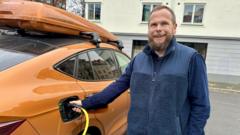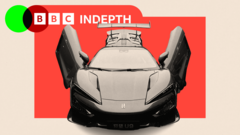Norway stands on the brink of groundbreaking change in the automotive landscape, poised to become the first nation to eliminate new fossil fuel vehicle sales, a feat largely attributed to long-standing supportive policies and a growing electric vehicle (EV) market.
Norway's Bold Move Towards a Sustainable Electric Future

Norway's Bold Move Towards a Sustainable Electric Future
As Norway leads the global transition to electric vehicles, the country's success offers lessons for the world.
Norway, with its population of 5.5 million, is now the world leader in electric vehicle adoption. In 2023, electric cars accounted for an astounding 88.9% of new car sales, with monthly figures peaking at near 98%—a remarkable feat virtually unrivaled globally. By early 2024, Oslo's leading car dealership, Harald A Møller, will only sell electric models, marking a significant shift in consumer preference. “It’s hard to go back,” stated CEO Ulf Tore Hekneby, emphasizing the practicality and performance benefits of electric cars over traditional combustion engines.
A significant development is that last year saw electric cars on Norway’s roads outnumber petrol vehicles for the first time, with electric models making up almost a third of all cars. In stark contrast, the UK and the US reported just 20% and 8% of new car sales as electric in 2024.
The roots of Norway’s electric vehicle revolution, which began in the early 1990s, lie in strategic government incentives that included tax exemptions for electric cars and increased taxes on fossil fuel vehicles. Additionally, benefits such as free tolls, free parking, and access to bus lanes promoted EV adoption. In light of Norway's intentions to have all new car sales be zero emission by 2025, these governmental policies have proven effective. Deputy Transport Minister Cecilie Knibe Kroglund expressed confidence in achieving this milestone, stating, "I think we have already made the transition for passenger cars."
Despite being a major oil exporter, Norway has articulated a future where its automotive landscape is dominated by electricity. The nation's extensive public charging infrastructure, which boasts over 27,000 charging stations, plays a vital role in promoting electric vehicle ownership. This is a stark contrast to the UK's 73,699 chargers for a population 12 times larger, with Norway having 447 chargers per 100,000 people compared to the UK’s 89.
Norwegian citizens, reflecting the shift in values, emphasize the financial advantages of electric vehicle ownership—coupled with the economic sanity given the absence of taxes on them. Public sentiment is shifting, as noted by new EV owners like Ståle Fyen, who articulated a change in mindset about charging practices. Meanwhile, industry representatives echo the belief that effective policy frameworks are essential for crafting similar electrification movements in other nations.
Norway’s wealth derived from its oil and gas industry facilitates significant reinvestment in EV infrastructure, bolstering its efforts towards sustainable transport. Renewable hydroelectric power, which represents 88% of Norway's energy production, further complements the nation's efforts, promising a future where the automotive fleet can run on clean energy.
As global markets begin to acknowledge EVs as the future of transportation, Norway’s model presents a viable pathway. Urban planners and policymakers in other nations now look towards Norway's playbook as a leading example of how effective policy, holistic approach, and public infrastructure can foster a seismic shift towards sustainable transport.
Whether other countries can replicate Norway’s success hinges not only on similar policies but also on adapting to the unique circumstances of their own markets. Norway's approach might well become an invaluable case study as the world collectively shifts gears towards a greener future.
A significant development is that last year saw electric cars on Norway’s roads outnumber petrol vehicles for the first time, with electric models making up almost a third of all cars. In stark contrast, the UK and the US reported just 20% and 8% of new car sales as electric in 2024.
The roots of Norway’s electric vehicle revolution, which began in the early 1990s, lie in strategic government incentives that included tax exemptions for electric cars and increased taxes on fossil fuel vehicles. Additionally, benefits such as free tolls, free parking, and access to bus lanes promoted EV adoption. In light of Norway's intentions to have all new car sales be zero emission by 2025, these governmental policies have proven effective. Deputy Transport Minister Cecilie Knibe Kroglund expressed confidence in achieving this milestone, stating, "I think we have already made the transition for passenger cars."
Despite being a major oil exporter, Norway has articulated a future where its automotive landscape is dominated by electricity. The nation's extensive public charging infrastructure, which boasts over 27,000 charging stations, plays a vital role in promoting electric vehicle ownership. This is a stark contrast to the UK's 73,699 chargers for a population 12 times larger, with Norway having 447 chargers per 100,000 people compared to the UK’s 89.
Norwegian citizens, reflecting the shift in values, emphasize the financial advantages of electric vehicle ownership—coupled with the economic sanity given the absence of taxes on them. Public sentiment is shifting, as noted by new EV owners like Ståle Fyen, who articulated a change in mindset about charging practices. Meanwhile, industry representatives echo the belief that effective policy frameworks are essential for crafting similar electrification movements in other nations.
Norway’s wealth derived from its oil and gas industry facilitates significant reinvestment in EV infrastructure, bolstering its efforts towards sustainable transport. Renewable hydroelectric power, which represents 88% of Norway's energy production, further complements the nation's efforts, promising a future where the automotive fleet can run on clean energy.
As global markets begin to acknowledge EVs as the future of transportation, Norway’s model presents a viable pathway. Urban planners and policymakers in other nations now look towards Norway's playbook as a leading example of how effective policy, holistic approach, and public infrastructure can foster a seismic shift towards sustainable transport.
Whether other countries can replicate Norway’s success hinges not only on similar policies but also on adapting to the unique circumstances of their own markets. Norway's approach might well become an invaluable case study as the world collectively shifts gears towards a greener future.

















